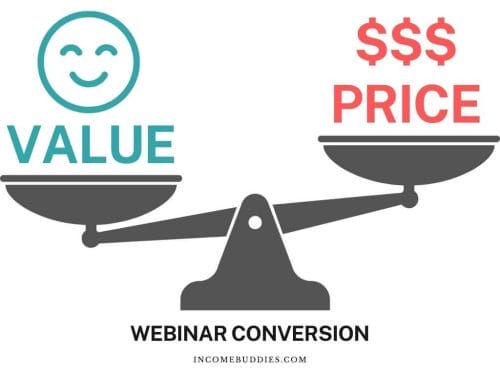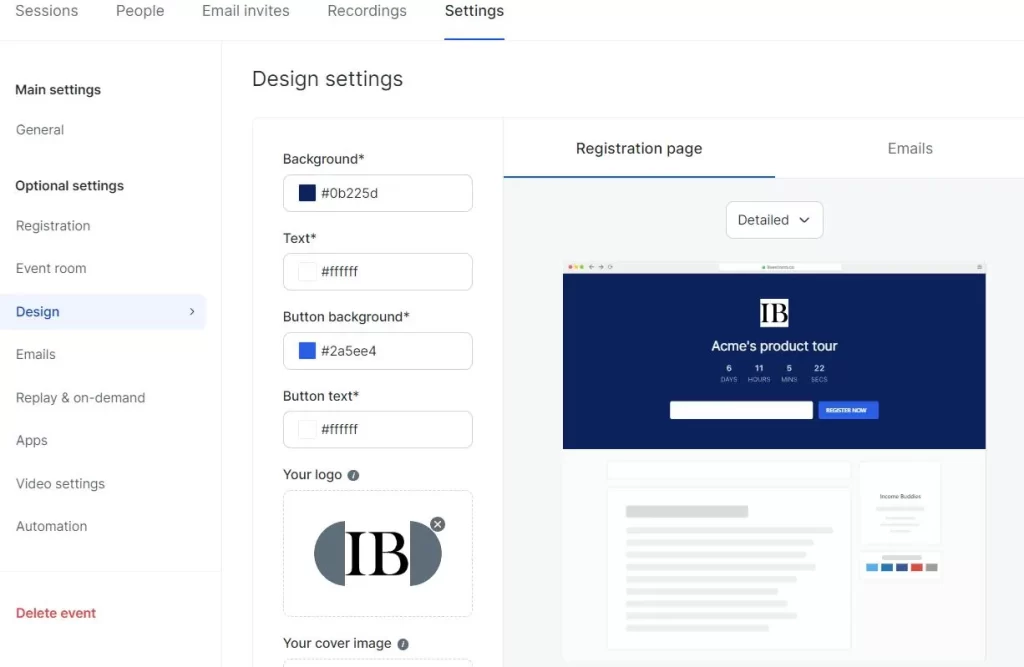Webinar Conversion Rate Metrics (Boost Conversion + New Tips)
Average webinar sales conversion rate is 2% to 5%, and if you are looking to grow your online business, webinars are the best way to get highly qualified leads.
Webinars are a powerful tool for:
- Edupreneurs, educators and online business owners.
- B2C marketers, B2B marketers and sales leaders.
Understanding webinar conversion rate and metrics that impact your business are key if you are creating and hosting a webinar.
KEY TAKEAWAYS
- Webinar conversion rate to sales averages at 2% to 5%, with as high as 15% sales conversion rate and 55% lead generation conversion rate.
- Tuesday to Thursday at 11am or 2pm are the best day and time to host your webinar for highest attendance rate, and a webinar of 46 minutes to 60 minutes have the highest registration rate.
- Factors influencing conversion rates includes; timing and scheduling, duration of the webinar, device the webinar is optimized for, how is the webinar being promoted.
Why Webinar is Important For Conversion
Webinar is a great marketing tools for generating leads, performing demonstration, delivering education to your audience on a particular topic.
Offering large group of participants to engage in online discussion, training and sharing of information, webinar can be used as a marketing channel that helps to build rapport and trust between the host and the participants.
Webinar Conversion Rates Metrics
When we want to create and host great webinars, understanding the key metrics associated with conversion rates is pivotal for any savvy marketer or business owner.
Let’s dissect the essential webinar conversion rate metrics to shed light on what truly matters in the world of online events.

1. Registration Page Conversion: ~30% to 51%
Webinar registration page serve as the landing page or sales page for your webinar, where potential attendees decide whether to commit in signing up.
Conversion rate depends on the type of traffic.
Cold Traffic: ~30% average conversion rate
Cold traffic, representing visitors unfamiliar with your brand, requires a compelling value proposition.
- ~30% average cold traffic conversion rate
Warm Traffic: ~51% average conversion rate
Warm traffic are audiences that have some prior engagement, are more receptive to your suggestions.
- ~51% average warm traffic conversion rate
How to Improve Registration Page Conversion Metric
Registration page conversion metric sets the tone for the entire webinar conversion process thus for a captivating registration page, consider the following:
- Compelling Content: Craft persuasive and informative content that highlights the value of your webinar.
- User-Friendly Design: Ensure an easy and intuitive registration process, minimizing friction for potential attendees.
- Strategic Placement of Information: Position key details such as date, time, and benefits prominently.
Transitioning from a passerby to a registered participant demands finesse.

2. Registrant to Attendee Show-Up Rate: ~40% to 57%
With registrations secured, the next hurdle is ensuring attendees show up when the virtual curtain rises.
This metric delves into the effectiveness of your pre-webinar strategies and the allure of your event.
- Average 40% registrant to attendee show-up rate
- Highest up to 57% registrant to attendee show-up rate
Attendance rate varies between industry as well:
| Industry | Average Show-Up Rate |
|---|---|
| Financial Services | 61% |
| Pharmaceutical | 61% |
| Consulting | 50% |
| SaaS | 46% |
| Advertising | 33% |
How to Improve Registrant to Attendee Show-Up Rate Metric
Getting registrants to actually attend your webinar is a huge hurdle that needs to be addressed. Here are a few things that can be done to improve the webinar attendance rate:
- Timing: Strategic scheduling of your webinar date and time that can cater to your audience’s convenience.
- Messaging: Engaging communication that builds anticipation
- Engagement: Creating pre-event buzz through teasers and exclusive content
- Effective Email Communication: Send engaging and reminder-filled emails to keep registrants excited about the upcoming event.
- Compelling Subject Lines: Capture attention with subject lines that highlight the value and uniqueness of your webinar.
Getting webinar attendees is not merely about getting them to sign up but crafting an experience that compels them to participate actively.
3. Attendee to Conversion Average: ~2% to 5% for Sales and 55% for Leads Generation
As the spotlight shifts from attendance to conversion, the focus narrows on turning engaged participants into leads and, ultimately, customers.
Leads Conversion Rate: ~55% Leads Generation
Leads conversion means to get your attendees to signup as high quality leads for future communications and connections.
- Averaging at 55% successful leads generation conversion
Sales Conversion Rate: ~2% to 5% and up to 15% Sales Conversion
Conversion into sales is the main reason why companies create and host webinars.
Amount the various marketing tools, webinar offers the most cost effective way to convert your audience into paying customers.
- Average Sales Conversion: 2-5% average conversion rate for most webinars in general industry
- High Sales Conversion: Peaks at 15% sales conversion when you’ve optimized your webinar for conversion.
How to Improve Registrant to Sales Metric
Converting attendees into leads or sales is the ultimate goal. Understanding the average conversion rates helps in setting realistic expectations.
Here are some things you can do to improve your registrant to sales metrics:
- Quality Content: Deliver content that aligns with your audience’s needs and pain points.
- Clear Call-to-Action (CTA): Guide attendees on the desired next steps, whether it’s signing up for a service or making a purchase.
The combined webinar experience from the webinar content, engagement, and a compelling offer transforms attendees into potential customers.
4. Attendee Stick Rate: ~57 minutes
The duration attendees stick around speaks volumes about the webinar’s efficacy.
- Average Webinars: 57 minutes Average View Time
However, the view time depends on the industry and topic as well:
- Marketing Webinars: 52 Minutes Average View Time
- Corporate Webinars: 55 Minutes Average View Time
- Training Webinar: 61 Minutes Average View Time
How to Improve Webinar View Time Metric
Balancing the amount of information and engagement is an art.
- Engaging Content Flow: Organize content logically to maintain attendee interest throughout the webinar.
- Interactivity: Incorporate polls, Q&A sessions, and other interactive elements to keep attendees actively involved.
The challenge lies in delivering value throughout the session, ensuring attendees stay until the end.
5. Replay View Rates: 25% Registrant
Webinar experience extends beyond the live session. Consider on-demand webinar, where your registrant can replay the live event.
Evaluating replay view rates provides insights into the content’s enduring appeal.
- Registrants Viewing Replays: 25% of registrant will reply the webinar.
How to Improve Replay View Rates
Replays cater to those who couldn’t attend live, expanding your reach and reinforcing the webinar’s value proposition.
Here are some ways to improve your replay view rates:
- Replay Promotion: Encourage registrants who missed the live event to watch the replay through follow-up emails and promotions.
- Accessible Platform: Ensure easy access to replay content on your webinar platform.
- Evergreen Content: Make your webinar content evergreen, so that your webinar viewers can get value out of your webinar anytime they watch.
Even after the live event, the impact of your webinar can continue through replays.
How to Calculate Your Ideal Webinar Conversion Rate
Not all webinar conversion rates are important for you as the host of the webinar. Some metric are much more important which can impact the bottom-line of your business and the success of your webinar event.
- Click-to-Sale: Visitor registered the webinar and become a potential webinar attendee to sale.
- Lead-to-Sale: Potential webinar attendee attend the webinar and become a webinar participant to sale.
- Show-Up-to-Sale: Webinar participant show-up to the webinar and become a customer by taking a desired action.
Let’s explore three key metrics to gauge the success of your webinar strategies.
1. Click-to-Sale: Cold or Warm Visitors to Sale
Click-to-sale measure the overall effectiveness of your webinar in driving sales.
This involves scrutinizing the entire funnel that gauges the effectiveness of your call-to-action (CTA) in converting interest into tangible results.
Click-to-Sale Conversion Rate (%) = (Number of Sales / Number of Clicks on CTA) x 100
2. Lead-to-Sale: Webinar Registration to Sale
Lead-to-sale measures the transition from lead generation such as registrations of the webinar event to sales conversion is the holy grail of webinar success.
Here you measure the efficiency of your nurturing process and the alignment between your offering and the audience’s needs, evaluating how effectively leads generated is translated into actual sales:
Lead-to-Sale Conversion Rate (%) = (Number of Leads Converted to Sales / Total Number of Leads) × 100
3. Show-Up-to-Sale: Webinar Attendee to Sale
Show-up-to-sale evaluate the attendees from showing up, attending the webinar to converting into customers.
Assessing the webinar presentation effectiveness in attracting, persuading and converting your audience to sales.
Show-Up-to-Sale Conversion Rate (%) = (Number of Sales / Number of Attendees) × 100
Factors that Affect Webinar Conversion Rate Metrics
Webinar conversion rates are influenced by many factors. Here, we explore various elements that play a role in shaping the success of your webinar campaigns.
1. Timing and Scheduling
Timing can make or break your webinar attendance rates. Let’s break down the optimal timing strategies for hosting a successful webinar:
Best and Worst Times to Host Webinars
- Best Time to Host: Research indicates that hosting webinars at 11 AM and 2 PM tends to yield the best results.
- Worst Time to Host: Interestingly, 12 PM (Noon) emerges as the least favorable time for webinars.
Best Days of the Week for Webinars
- Best Days to Host: Thursdays take the lead as the best day of the week for hosting webinars.
- Good Days to Host: Tuesdays and Wednesdays closely follow, presenting themselves as strong alternatives.
2. Device Usage and Accessibility
Understanding how your audience accesses and engages with your webinar can significantly impact conversion rates. Here’s a closer look at device usage:
Devices Used by Attendees
- Laptops or Desktops:77% of attendees prefer joining webinars through laptops or desktops, emphasizing the importance of optimizing for these platforms.
- Tablets: 13% opt for tablets when attending webinars
- Mobile: 10% utilize mobile devices for webinars
3. Duration of Webinar
Attendance duration and the length of the webinar have a strong correlation on the percentage of the webinar viewed by attendees.
| Webinar Length | Webinar Attendance Length | Attendance Rate (Calculated) |
|---|---|---|
| 20 Mins | 14 Mins | 70% |
| 40 Mins | 28 Mins | 70% |
| 50 Mins | 35 Mins | 70% |
| 60 Mins | 42 Mins | 70% |
| 70 Mins | 49 Mins | 70% |
| 80 Mins | 56 Mins | 70% |
| 100 Mins | 64 Mins | 64% |
| 120 Mins | 73 Mins | 61% |
| 140 Mins | 89 Mins | 64% |
| 160 Mins | 96 Mins | 60% |
| 180 Mins | 111 Mins | 62% |
Webinar that is less than 80 minutes have an calculated attendance rate of approx. 70%, and this drastically drop when the webinar extend beyond 80 minutes to as low as 60%.
Best Length of the Webinar
Best length of webinar should be long enough for informative sessions garner, and short enough that the information is concise and keep your attendees engaged.
- Best Webinar Duration Range: 46 to 60 minutes attracts the most attendees for webinar
- Best Webinar Duration Length: 60 minutes is the most popular that leads to highest conversion.

4. Registration Trends
Analyzing registration trends can provide insights into audience behavior and help tailor your promotional strategies:
Early Registrations vs. Last-Minute Registrations
- 24% of attendees register for webinars 15 or more days before the event, showcasing the significance of early promotional efforts.
- 10% register on the day of the webinar, highlighting the need for last-minute promotional pushes.
Sources of Registrations
Sources of registration can have huge impact on the conversion rate.
- Email campaigns: Account for 60% of all webinar registrations, underlining the continued effectiveness of email marketing in webinar promotion.
- Advertising: Account for 40% of registrations with highly targeted audience and optimized advertising campaigns.
- Social media and Word-of-Mouth: Account for 15%. of registrations with platforms like LinkedIn, Twitter, and Facebook.
Best Practices to Improve Your Webinar Conversion Rates
Webinar virtual event is a powerful marketing strategy for both B2B marketers and B2C marketers. Webinar marketing is the best way to generate high-quality leads that converts.
Let’s take a look at some best practices that can transform your average webinar into a sales funnel with the help of the top webinar software that ensure maximum engagement, conversion, and overall success.
1. Improving Registration Page Conversion
Your journey towards a successful webinar begins with an enticing registration page. This webinar landing page is the gateway where potential attendees decide whether to commit to your event. To boost your registration page conversion rate:
- Craft a Compelling Headline: Capture attention with a concise, benefit-driven headline.
- Highlight Key Takeaways: Clearly outline what attendees will gain from the webinar.
- Optimize Form Length: Keep registration forms concise, balancing information gathering with user convenience.
- Strategic Placement of CTAs: Ensure prominent and strategically placed call-to-action buttons.
2. Enhancing Show-Up Rates
Getting registrants to attend your live webinar is a critical challenge. To increase show-up rates:
- Early Engagement Emails: Send engaging emails pre-event, creating anticipation and excitement.
- Personalized Reminders: Leverage personalized reminders closer to the event to keep it top of mind.
- Provide Incentives: Offer exclusive bonuses or content only accessible to live attendees.
- Interactive Elements: Incorporate polls, Q&A prompts, and interactive content during the webinar to maintain engagement.
3. Increasing Engagement During Webinars
Engagement is the heartbeat of a successful webinar. To keep your audience hooked:
- Dynamic Content Delivery: Avoid monotony by varying content types – slides, videos, live demos.
- Polls and Surveys: Integrate polls to gauge audience opinions and keep them actively participating.
- Encourage Q&A Interaction: Foster a conversational atmosphere by addressing attendee questions.
- Strategic Breaks: Incorporate short breaks to maintain energy levels and attention spans.
4. Strategies for Higher Conversion Rates
Conversion is the ultimate goal. Here’s how to maximize your chances:
- Compelling CTAs: Clearly articulate the next steps you want attendees to take.
- Showcase Social Proof: Share success stories, testimonials, or previous attendee experiences.
- Limited-time Offers: Create a sense of urgency with time-sensitive promotions for your product or service.
- Provide Valuable Resources: Offer additional resources related to your webinar content for further engagement.
5. Incorporating CTAs (Call to Action)
The Call to Action (CTA) is your navigation beacon guiding attendees toward the next stage. To optimize CTAs:
- Strategic Timing: Introduce CTAs toward the end of your webinar after delivering substantial value.
- Diverse Actions: Prompt attendees to subscribe to premium content, join mailing lists, or schedule demos.
- Tailored Messaging: Align CTA messaging with the overall theme and objectives of your webinar.
| Action | Timing | Purpose |
|---|---|---|
| Join your mailing list | Towards the end | Nurture leads for future engagement |
| Subscribe to premium content | Post-value delivery | Identify high-interest prospects |
| Complete a survey | Mid-webinar | Gather feedback for continuous improvement |
| Sign up for a free trial | Post-case study | Convert interested leads into trial users |
| Schedule a demo | End of webinar | Cater to prospects ready for personalized engagement |
Time To Improve Your Webinar Metrics
Using webinar for your business is a powerful content marketing strategy, and this is regardless of the different types of webinar that you are hosting.
While most webinar we see are live webinars, there are other forms of webinars that you may also want to consider.
- Evergreen Webinars: Consider converting successful webinars into on-demand content for continuous lead generation.
- Just-In-Time (JIT) Webinars: Consider just-in-time webinar which offers your attendees the option to attend webinar in the next few minutes when their interest is at it’s peak.
- On-Demand Webinars: Consider converting your webinar into a webinar library where your visitors can view whenever they want.
And if you are unsure how to create and host your webinar or still trying to find the best webinar platforms to get started, here is my suggestion:
- Handpicked webinar software platforms for business and education
- Automated webinar software for on-demand, evergreen and just-in-time webinar
Incorporating webinar into your business can significantly elevate your business growth
With this insights, you can significantly elevate your webinar metrics and increase your average webinar conversion rate.
- 7 Best Teachable Alternative for Course Creators (Free and Paid)
- LearnWorlds Features: In-Depth eLearning LMS Overview
- ThinkiFic Features: Course Creator’s In-Depth Overview
- 200+ Best Online Course Ideas For New Course Creators of Every Niche (Updated)
- +59 Best Proven Membership Site Ideas to Get Started This Year (Read First)
Join 900+ BUDDIES who are growing their wealth with our weekly Income Newsletter
Antony C. is a dividend investor with over 15+ years of investing experience. He’s also the book author of “Start Small, Dream Big“, certified PMP® holder and founder of IncomeBuddies.com (IB). At IB, he share his personal journey and expertise on growing passive income through dividend investing and building online business. Antony has been featured in global news outlet including Yahoo Finance, Nasdaq and Non Fiction Author Association (NFAA).

